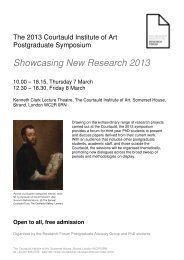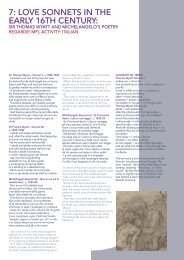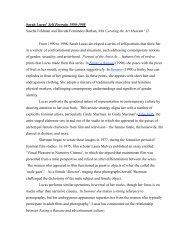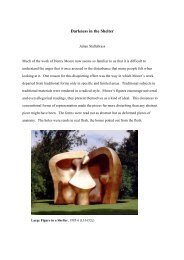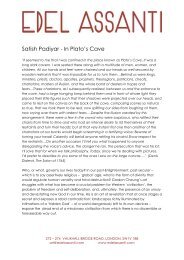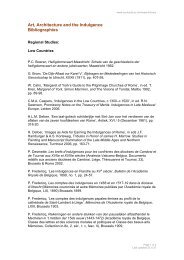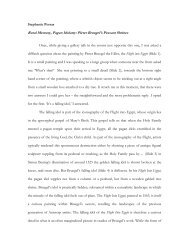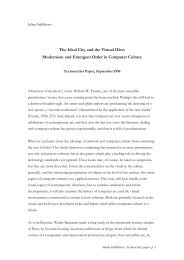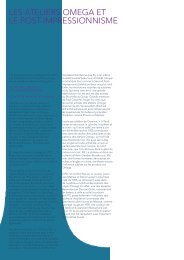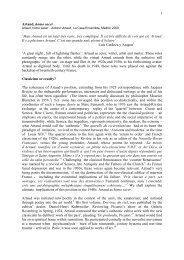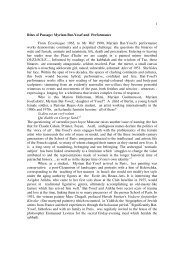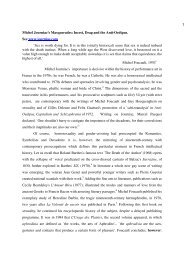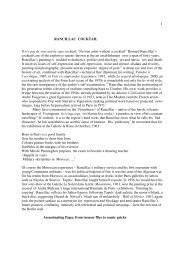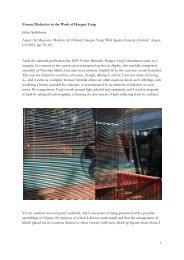TEACHERS' RESOURCE - The Courtauld Institute of Art
TEACHERS' RESOURCE - The Courtauld Institute of Art
TEACHERS' RESOURCE - The Courtauld Institute of Art
You also want an ePaper? Increase the reach of your titles
YUMPU automatically turns print PDFs into web optimized ePapers that Google loves.
1: CÉZANNE’S<br />
CARD PLAYERS<br />
INTRODUCTION TO THE EXHIBITION<br />
Paul Cézanne’s famous paintings <strong>of</strong> peasant<br />
card players and pipe smokers have long<br />
been considered to be among his most<br />
iconic and powerful works. This landmark<br />
exhibition, organised by <strong>The</strong> <strong>Courtauld</strong><br />
Gallery in London and <strong>The</strong> Metropolitan<br />
Museum <strong>of</strong> <strong>Art</strong> in New York, is the first<br />
to focus on this group <strong>of</strong> masterpieces.<br />
Described by Cézanne’s early biographer,<br />
Gustav Coquiot, as being “equal to the<br />
most beautiful works <strong>of</strong> art in the world”,<br />
this is a unique opportunity to enjoy these<br />
remarkable paintings in unprecedented<br />
depth. <strong>The</strong> exhibition will bring together<br />
the most comprehensive group <strong>of</strong> these<br />
works ever staged, including three <strong>of</strong><br />
the Card Players paintings, five <strong>of</strong> the<br />
most outstanding peasant portraits and<br />
examples <strong>of</strong> the exquisite preparatory<br />
drawings, watercolours and oil studies the<br />
artist produced. Cézanne’s Card Players<br />
stand alongside his Bathers series as the<br />
most ambitious and complex figurative<br />
works <strong>of</strong> his career.<br />
<strong>The</strong> first mention <strong>of</strong> the Card Players series<br />
comes in 1891 when the writer Paul Alexis<br />
visited Cézanne’s studio in Aix-en-Provence<br />
and found the artist painting a local<br />
peasant from the farm on his estate, the<br />
Jas de Bouffan. A number <strong>of</strong> different farm<br />
workers came to sit for him during these<br />
years, <strong>of</strong>ten smoking their clay pipes. <strong>The</strong>y<br />
included an old gardener known as le père<br />
Alexandre and Paulin Paulet, who posed<br />
as the figure seated on the left in two<br />
figure Card Players compositions, a task for<br />
which he was paid five francs. Cézanne’s<br />
depictions <strong>of</strong> card players would prove to<br />
be one <strong>of</strong> his most ambitious projects and<br />
occupied him for several years. It resulted<br />
in five closely related canvases <strong>of</strong> different<br />
sizes showing men seated at a rustic table<br />
playing cards, the exhibition includes tw<strong>of</strong>igure<br />
versions versions from <strong>The</strong> <strong>Courtauld</strong><br />
Gallery and <strong>The</strong> Musée d’Orsay and a<br />
more complicated composition from <strong>The</strong><br />
Metropolitan Museum.<br />
Alongside these he produced a larger<br />
number <strong>of</strong> paintings <strong>of</strong> the individual farm<br />
workers who appear in the Card Players<br />
compositions.<br />
Cézanne devoted himself to his peasant<br />
card players, <strong>of</strong>ten repeating his<br />
compositions, striving to express the<br />
essence <strong>of</strong> these sun-beaten farm workers<br />
whom he found so compelling. Rather than<br />
posing his models as a group playing cards,<br />
Cézanne made studies <strong>of</strong> them individually<br />
and only brought them together as<br />
opponents on the canvas itself. For him,<br />
the local peasants <strong>of</strong> Aix were the human<br />
equivalent <strong>of</strong> his beloved Montaigne<br />
Sainte-Victoire that presided over the town<br />
– steadfast, unchanging and monumental.<br />
As he later put it, “I love above all else the<br />
appearance <strong>of</strong> people who have grown old<br />
without breaking with old customs”.<br />
Cézanne’s card players are not shown as<br />
rowdy drinkers and gamblers in the way<br />
that, for centuries, peasants had been<br />
depicted in rural genre paintings. Rather,<br />
they are stoical and completely absorbed<br />
in the time-honoured ritual <strong>of</strong> their game.<br />
As the famous English critic Roger Fry<br />
wrote in 1927:<br />
“It is hard to think <strong>of</strong> any design since those<br />
<strong>of</strong> the great Italian Primitives… which gives<br />
us so extraordinary a sense <strong>of</strong> monumental<br />
gravity and resistance – <strong>of</strong> something that<br />
has found its centre and can never be<br />
moved.”<br />
<strong>The</strong> monumentality <strong>of</strong> the works epitomise<br />
Cézanne’s stated aim to produce<br />
“something solid and durable, like the art<br />
<strong>of</strong> the museums”. Appropriately, one <strong>of</strong> the<br />
first works by Cézanne to enter a museum<br />
collection was Musée d’Orsay Card Players,<br />
which was accepted by the Louvre in 1911,<br />
five years after the artist’s death.<br />
Perhaps the most remarkable aspect <strong>of</strong><br />
Cézanne’s card player and peasant works<br />
is that their evocation <strong>of</strong> unchanging<br />
traditions was achieved by pushing the<br />
boundaries <strong>of</strong> painting in radical new<br />
directions. Cézanne painted freely and<br />
inventively, rendering his peasants through<br />
a vibrant patchwork <strong>of</strong> brushstrokes which<br />
animates the surface <strong>of</strong> the paintings.<br />
For most nineteenth-century viewers<br />
Cézanne’s technique would have appeared<br />
as coarse as his peasant subject matter but<br />
the Card Players would prove an inspiration<br />
to later generations <strong>of</strong> avant-garde artists.<br />
For Pablo Picasso, Cézanne’s peasants<br />
were a touchstone for his Cubist portraits<br />
and their example resonates throughout<br />
the twentieth century with particular<br />
homages paid to them by artists as diverse<br />
as Fernand Léger and Jeff Wall.<br />
<strong>The</strong> <strong>Courtauld</strong> Gallery’s world-renowned<br />
Cézanne collection includes two <strong>of</strong> the<br />
masterpieces from this series, a two-figure<br />
version <strong>of</strong> <strong>The</strong> Card Players and Man with<br />
a Pipe (see right). <strong>The</strong> exhibition also<br />
includes major loans from international<br />
collections, including <strong>The</strong> Metropolitan<br />
Museum <strong>of</strong> <strong>Art</strong>, which will be the second<br />
venue for the exhibition from February<br />
2011.<br />
Cézanne’s creation <strong>of</strong> a relatively large<br />
number <strong>of</strong> preparatory works for the Card<br />
Players paintings was highly unusual and<br />
indicates his commitment to this ambitious<br />
series. In preparation for the exhibition,<br />
<strong>The</strong> <strong>Courtauld</strong> and <strong>The</strong> Metropolitan<br />
Museum collaborated on the first technical<br />
research project to look systematically at<br />
this group <strong>of</strong> works. This has shed fresh<br />
light on Cézanne’s working practice. Most<br />
importantly, by examining the extent<br />
<strong>of</strong> underdrawing on each canvas it has<br />
challenged established views about the<br />
sequence in which he produced the<br />
paintings. Whereas it has traditionally<br />
been assumed that he worked from the<br />
largest paintings to the smallest, gradually<br />
simplifying the scenes, it now seems clear<br />
that he started the series with the smaller<br />
canvases, using them to establish his iconic<br />
compositions.<br />
Right:<br />
Man with a Pipe<br />
c.1892–96<br />
Oil on canvas<br />
CURRICULUM LINKS: KS3+<br />
<strong>Art</strong> and Design, History, <strong>Art</strong> History,<br />
Sociology, and other Humanities



